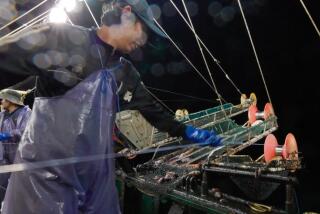Sushi Lovers Could Eat Bluefin Tuna Into Extinction : Conservationists fear Japan’s craving for the species may be its undoing. In 20 years, its numbers have declined 90%.
- Share via
WASHINGTON — Sushi and sashimi--Japan’s two most prominent raw fish delicacies--are the world’s newest villains in the battle to save endangered species.
Environmentalists say Japan’s seemingly insatiable appetite for raw fish is threatening to kill off the giant bluefin, the fat, delectable Atlantic tuna that is the staple of both dishes.
Scientists estimate that, as recently as 20 years ago, more than 300,000 giant bluefin a year migrated along the western Atlantic. But years of overfishing have reduced that number to only 30,000. And conservationists fear that the fish may soon virtually disappear from U.S. waters.
Under quotas set by the 23-nation International Convention on the Conservation of Atlantic Tunas (ICCAT), the United States, Canada and Japan catch 2,660 metric tons of bluefin in the western Atlantic each year. The U.S. share is 1,500 tons. Two-thirds of that winds up in Tokyo.
THE ISSUE: The economics of tuna fishing encourages species depletion. With raw fish dishes so popular in Japan, prime bluefin fetches as much as $40 a pound there, making a single giant tuna--which can weigh 600 pounds by the time it is 30 years old--worth almost $24,000.
Moreover, with the numbers of giant bluefin on the decline, the depletion has led to increased pursuit of smaller fish, even the juveniles that provide the breeding population for the future.
The giant Atlantic tuna, one of the largest bony fish in the world, migrates over vast distances--from its spawning grounds in the Gulf of Mexico in early spring north through the summer to the waters off New England, Nova Scotia and Newfoundland.
With these migratory patterns--and the fact that some tuna linger in areas of the Gulf Stream--fishing goes on year-round.
THE CONTROVERSY: Conservationists and environmental groups are pushing for new international action to limit the worldwide catch.
In 1981, ICCAT imposed a quota of 1,160 metric tons for the catches of the western Atlantic. Its scientific committee recommended that the limit be “as near zero as feasible” for the succeeding two years.
But protests from fishermen--and a continuing dispute over the actual size of estimated stocks--led officials to raise the quota back to 2,660 tons in 1982. It has remained there since.
Not surprisingly, American environmentalists are pressing for stricter quotas. And they want the 100-country Convention on International Trade in Endangered Fauna and Flora to place the fish under its protection at a meeting next March in Kyoto, Japan.
Many scientists and groups such as the World Wildlife Fund want to see giant bluefin fishing in the northwest Atlantic stopped entirely.
The Bush Administration is steering something of a middle course. It refused to call for placing the bluefin problem on the trade in endangered species convention’s agenda at the Kyoto meeting. Instead, the U.S. Marine Fisheries Service has recommended that American negotiators seek to cut the western Atlantic quota by half at ICCAT’s annual meeting in Madrid next month. Washington contends that tuna protection should remain in the hands of ICCAT.
OUTLOOK: For the moment, environmentalists are disappointed. “We never anticipated that the United States would support a (Convention on International Trade in Endangered Fauna and Flora) listing,” said Mike Sutton, a senior project officer for the World Wildlife Fund. “The commercial fishing lobby is too powerful to resist.”
But the fight may not be over. Sweden has formally called on the Kyoto meeting to ban all international trade in giant bluefin tuna, ensuring that the issue will be on the convention’s agenda after all.
More to Read
Sign up for Essential California
The most important California stories and recommendations in your inbox every morning.
You may occasionally receive promotional content from the Los Angeles Times.













